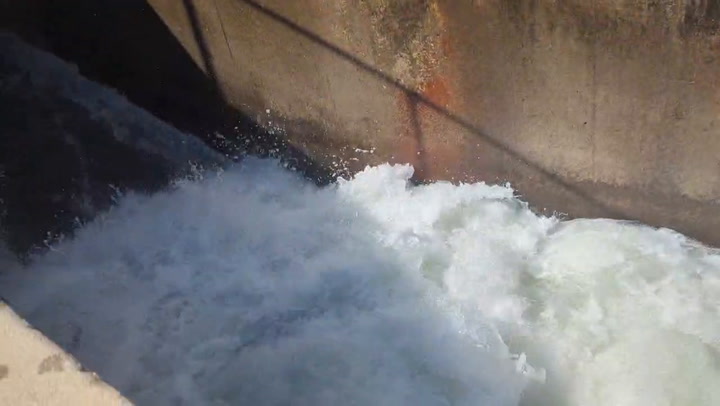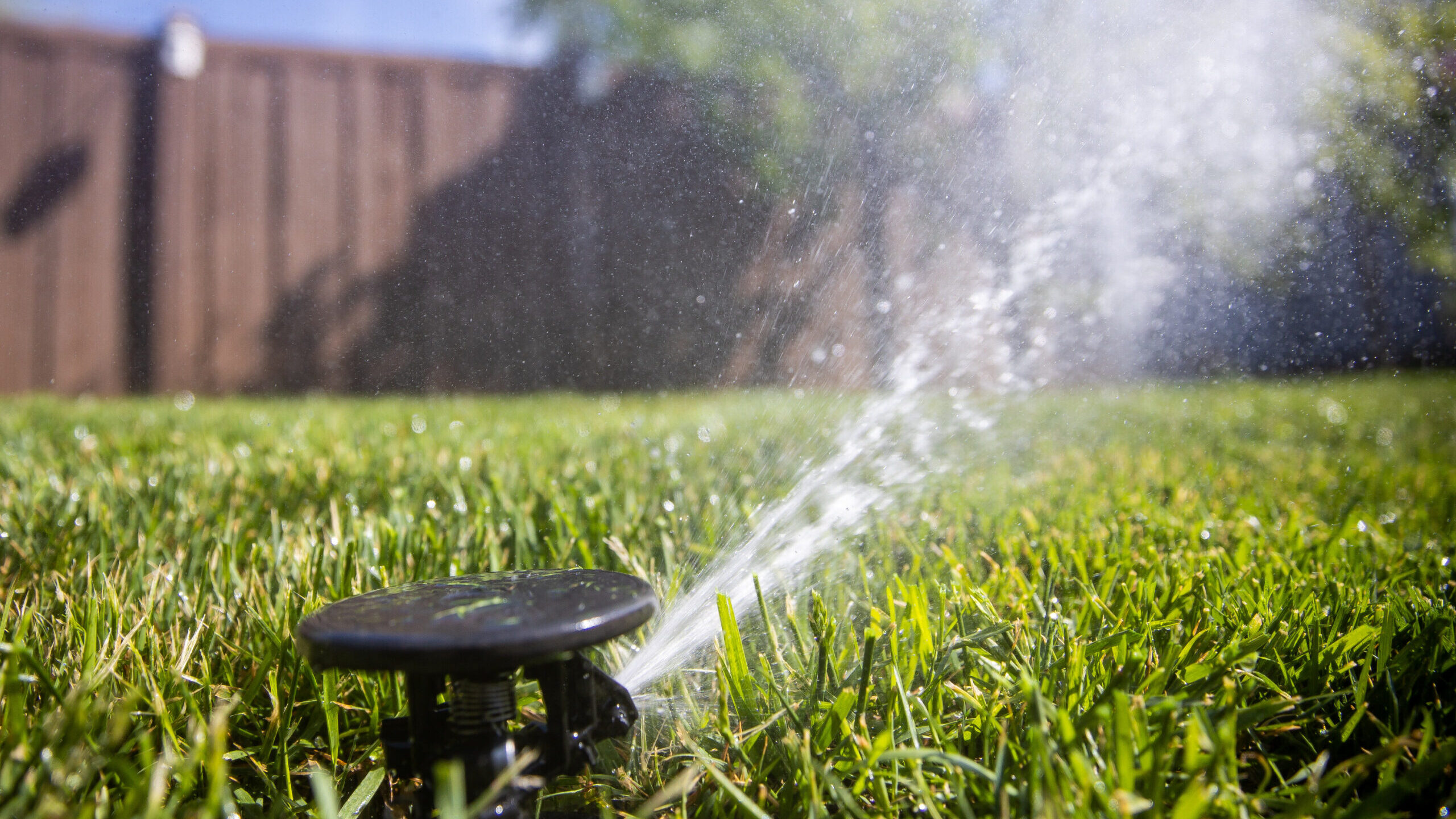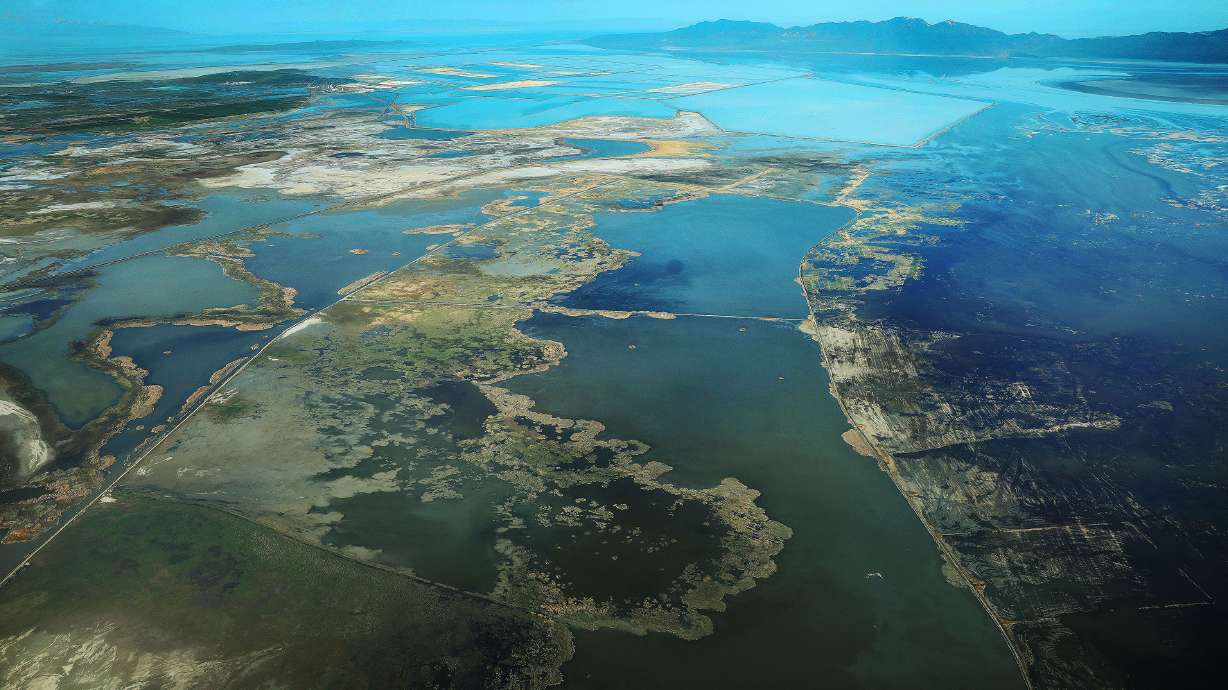UTAH DROUGHT
Dear Legislature: Here’s what you can do in 2023 to save the Great Salt Lake
Jan 4, 2023, 8:00 AM

Fruit orchards abut property advertising lots for sale in Willard in July. (Photo: (Leah Hogsten, The Salt Lake Tribune)
(Photo: (Leah Hogsten, The Salt Lake Tribune)
This article is published through The Great Salt Lake Collaborative: A Solutions Journalism Initiative, a partnership of news, education and media organizations that aims to inform readers about the Great Salt Lake.
Para leer este artículo en español, haz clic aquí.
Advocates, farmers and lobbyists serve up solutions for rescuing the hemorrhaging body of water.
Will Utah save the Great Salt Lake before it’s too late?
That’s the question on many minds this winter as lake levels hit record lows for the second year in a row and hyper-salinity threatens brine fly and shrimp populations.
Last year, the state Legislature passed a flurry of bills and allocated a $40 million trust in hopes of saving the shrinking Great Salt Lake. The U.S. Congress also set aside millions in two separate bills to study drying saline lakes in the West, with the backing of Sen. Mitt Romney and most of Utah’s representatives in the House. Meanwhile, Gov. Spencer Cox has asked lawmakers to invest an additional $132.9 million in his December budget proposal.
While money is flowing to the lake, some worry water has yet to do the same. The Great Salt Lake is already in the early stages of ecological collapse. Some of the policies enacted could take decades to see results, environmentalists warn.
The Salt Lake Tribune spoke to lobbyists, environmental advocates, the agriculture industry, researchers and other stakeholders about what other policies they’d like to see in the upcoming legislative session, which kicks off on Jan. 17.
1. Lake-based industries: Support engineered solutions
Brine shrimp harvesting and mineral extraction funnel millions into Utah’s economy each year, but companies are on the verge of seeing their profits evaporate along with the lake’s rapidly receding water.
US Magnesium is trying to get a permit to extend its intake canals – a proposal that has received a deluge of opposition from the public and a tepid response from state resource managers.
Tom Tripp, director of technical services for US Magnesium and a Tooele County Council member, said lawmakers should explore water lost off the lake to evaporation to slow its decline.
“The problem is,” Tripp said, “we’re so dry you cannot conserve yourself out of this problem.”
The Great Salt Lake loses about 2 million acre-feet through evaporation each year, which means it needs about the same amount flowing to it to maintain a sustainable elevation. This year, only about 1.2-million acre-feet reached the lake through its tributary rivers.
Tripp suggests the state segment off the Great Salt Lake to create patches where salinity levels are low enough to sustain brine shrimp and brine flies, along with the millions of birds that feed on them.
“[You] Create an island of a healthy environment and ecosystem,” Tripp said, adding that he was putting forth his own ideas and not speaking on behalf of US Magnesium.
Compass Minerals, the lake’s other large mineral extraction company, declined to comment for this story.
While engineering the lake to control for evaporation and salinity might sound extreme, it’s already happening. State managers are using a railroad causeway that bisects the lake to seal off the lake’s saltier north arm, preventing brine from flowing to the south arm and further spiking salinity levels.
It’s a solution Timothy Hawkes, vice chair for the Great Salt Lake Brine Shrimp Cooperative and a former state representative, said he supports.
“Short term,” he said, “it’s really vital that we reverse lake declines and that we manage for salinity.”
Hawkes also backs an idea popular among Utah lawmakers and resources managers – paying farmers to lease out their water rights and divert them to the Great Salt Lake.
It would be an “emergency lever,” Hawkes said, “that will take funding from the Legislature.”
Gov. Cox’s budget proposal calls for $100 million for short-term water leases from agriculture, which lawmakers will need to approve.
And Joel Ferry – a farmer in the Great Salt Lake Basin, former state representative, and current director of the Department of Natural Resources – has floated the idea of paying farmers to let their fields temporarily go fallow until lake levels rise.
“We would then shepherd that water directly down to the lake, and it would have an immediate impact,” Ferry told the Legislative Water Development Commission last month.
2. Farmers: Skeptical about giving up their water and want more assurances
Utah’s agricultural industry so far seems reluctant about the state’s proposal to lease and move their water downstream.
“The idea of taking farm ground out of production … it’s somewhat concerning,” said Matt Hargreaves, a spokesperson for the Utah Farm Bureau.
What’s clear is that lawmakers will need farmers to get on board with any policies meant to help the Great Salt Lake. They divert about 63% of the water that would otherwise flow to the lake. But they’re also the basin’s most flexible water users, oftentimes taking bigger cuts to their water use in dry years than cities and
“This is a Utah problem,” said Farm Bureau Vice President of Public Policy Terry Camp of the lake. “We’re all in this together. Ag wants to be a partner.”
One policy agriculture lobbyists do support is more funding for Utah’s Water Optimization Program, a grant that helps farmers install more efficient irrigation systems. The program has saved more than 7 billion gallons of water statewide since it started in 2019, according to the Department of Agriculture and Food. Cox has asked lawmakers to direct another $200 million to the program. To qualify, farmers need to meter their use and prove they’re diverting less.
Still, there’s some concern that all the water saved and left in the lake’s tributary rivers could impact farmers’ water rights.
“The state engineer says there are some protections there,” said Wade Garret, who lobbies for the Farm Bureau as vice president of strategic relationships and advocacy. “Some ag folks are worried there isn’t [protection] and it’s something that definitely needs to be explored.”
3. Lake researchers and advocates: It’s time for drastic measures
Farmers’ reluctance combined with the Great Salt Lake’s dire status has those who study it calling for bolder action, particularly with conservation.
Robert Baskin, a retired U.S. Geological Survey scientist who has done extensive research on the lake, called for a trigger elevation that bars companies like US Magnesium from pumping water out of the lake when its salinity levels spike.
Such a policy would give companies “some sort of limitation and some way to plan ahead if the lake starts dropping again,” Baskin said. “That puts them in a position to moderate layoffs and … also incentivize them to make sure there’s enough water getting to the lake.”
Continued development on the south shore of the lake is further imperiling high quality bird habitat, said Heather Dove, president of Great Salt Lake Audubon.
The area north of the proposed inland port is of particular concern. “I really think the state needs to step up and either buy that land outright and set it aside,” Dove said, “or at least help to pay for conservation easements for that area so it is protected.”
“I think that this legislative session is going to seal the fate of these birds,” Dove added. “Either they pull it together and do what’s needed, or everything’s going to die.”
The lake’s ecosystem is hemorrhaging, agreed Carie Frantz, an associate professor of geochemistry and geobiology at Weber State University who also studies the Great Salt Lake’s microbialites. It might take decades for it to rebound if things don’t improve this summer.
“We need to declare a water emergency and do everything we can, no matter how painful it is, to put water back in the lake,” Frantz said.
“We can’t be approving any new projects that require water,” she said. “I would like to see that any new water uses are only approved if they are somehow able to prove it will lead to 10% savings elsewhere.”
She also called for guarantees that water districts will continue to send water to the lake until it recovers.
Water districts’ property tax structure also incentivizes wasteful water use, according to Zachary Frankel, longtime executive director of Utah Rivers Council.
“When will we get serious about saving water?” he said.
The council released a study that found last year the state’s five biggest water districts raised $133 million in tax revenue. Frankel wants this policy to change, forcing big water users to pay for the cost of water through rates rather than receiving a de-facto subsidy from property taxes.
Frankel appeared to find an ally to his cause in Sen. Daniel McCay, R-Riverton, who proposed draft legislation in October revoking cities and water districts’ rights to use “property tax revenue to pay for certain costs related to supplying culinary or irrigation water.”
However, the latest version of McCay’s bill is a far more modest proposal to simply study “the use of property tax revenue to fund water infrastructure, treatment, and delivery.”
Meanwhile, researchers have also found toxic dust is already blowing from the Great Salt Lake’s sprawling exposed bed, creating a public health risk to millions living on the Wasatch Front. But it’s an issue that has received little state funding or attention to date.
“We want to know when dust is coming in, where it’s hitting communities, how to install monitors in the best places,” said Alex Veilleux, a policy associate with HEAL Utah.
HEAL plans to lobby lawmakers to do a comprehensive study of dust pollution, including sources beyond the lake. And it’s a concept that might receive support – Cox has requested $160,000 to study the lakebed dust issue.
While Frankel said he is supportive of scientific research and studies, he worried that “we are still lacking the political will to act.
“There’s a lot of money going into studies,” Frankel said. “And those studies are going to educate a new generation of elected officials who will leave office understanding what should have happened.”
Related:
- Will December’s big storms make a difference for the Great Salt Lake?
- Can water-wise landscaping help save the Great Salt Lake?













